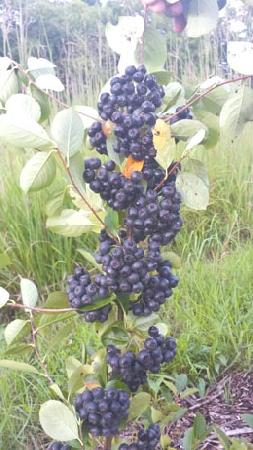 It's possible that one of the hottest new health foods is already growing on your property, especially if you live along the East Coast. Aronia, which is better known as black chokeberry is now considered a "superfood". If you aren't among the few lucky enough to have it growing wild, you can buy seedlings to grow for your own use ? or commercially to meet the growing market demand.
It's possible that one of the hottest new health foods is already growing on your property, especially if you live along the East Coast. Aronia, which is better known as black chokeberry is now considered a "superfood". If you aren't among the few lucky enough to have it growing wild, you can buy seedlings to grow for your own use ? or commercially to meet the growing market demand.
"The antioxidant percentage is so much higher than acai berries, blueberries and goji berries. It's just being rediscovered in North America," says Bob Pertzborn, a board member of the Midwest Aronia Association, who grows 1,200 aronia shrubs on his Ankeny, Iowa, property. He points out that Native Americans and pioneers ate the berries, which also protected their skin from sun damage.
The aronia association was organized in 2008, after Iowa State University Extension research provided production information, and producers recognized aronia as a value-added crop.
"The varieties are out of Europe because they are better performing than native varieties," Pertzborn says. Commercial growers plant varieties including Viking, Galicjanka, McKenzie and Nero.
The 4 to 12-in. plugs are planted with a tree planter 2 1/2 to 5 ft. apart in rows 14 to 15 ft. apart. Growers often install electric fence if deer are a problem because they like to pull up small trees. Rabbits also like to nibble on the young trees, but that only makes the roots more developed and the trees recover, Pertzborn says. Birds don't like the berries so they don?t present a problem.
If the soil is good and there is no competition from grass and weeds, aronia bears fruit in the third or fourth year and can produce up to 20 to 35 lbs./year when mature. The shrubs grow up to 12 ft. tall and thrive for decades on most soils. One practice is to cut them back every 14 years or so and prune out the weakest canes and let them grow again.
"They need the freeze cycle to produce berries," Pertzborn notes. So they can be grown in Canada and the upper half of the U.S. In addition to the Iowa-based group, the Mid Atlantic Aronia Growers Association serves New England growers.
A range of growers from hobby farmers to large-acreage crop farmers plant aronia for extra income or to diversify.
Pertzborn planted his shrubs in a field that had been in grass/wildflowers for 5 years. He used landscape fabric covered by woodchips to prevent weed competition and harvested berries in the third year. Mechanical harvesters similar to blueberry pickers are used to pick the ripe fruit in mid-August to mid-September.
The deep purple berries have a soft seed and are rather tart. While a few people like to eat them fresh, most prefer them in recipes, such as jams, jellies, juices, desserts or vinaigrettes.
"There are 240 aronia items in grocery stores right now,? Pertzborn says. Many producers use organic growing practices and sell the berries wholesale. Others sell direct or create their own products. Prices range from $1 to $12/lb. depending on the market.
For people interested in making their own food, the Midwest Aronia Association is the best source for recipes, says Brenda Gorseth, a North Dakota caterer (www.woodwardfarm.com) who also does custom baking and makes original jams, relishes and salsas from food grown on her Cathay, N. Dak., property.
" love aronia berries," she says. "It's a clean berry to work with; it holds its shape. I like how versatile they are. The chili is delicious and they make a nice rich sauce with chocolate."
She and about 50 other North Dakota aronia enthusiasts met this winter to sample everything from pepper jam to sausage to smoothies with aronia as the star ingredient, and to discuss possibly forming a cooperative to share the cost of the harvester and marketing.
"Area farmers have been planting them in the tree lines for conservation, because they are hardy, the deer don't bother them, and they don?t winter kill," Gorseth says. Some growers are planting 40 acres or more to diversify, and a local winery, Dakota Sun Gardens, won a gold cup for its aronia wine at a prestigious competition.
"People like that aronia berries are not overly sweet and are healthy," Gorseth adds, noting she is eager to harvest her own berries next year to develop salsa and vinaigrette recipes.
Aaron Opdahl harvested a ton of berries off 300 shrubs in one year and makes wine. He hosted the North Dakota meeting because he's excited about the health benefits and opportunities, though he's never considered himself a big health nut.
"I was putting in a windbreak and aronias were on the list. Now we are hooked big time," he says. The shrubs are hardy in North Dakota's harsh winters and haven't had any pest issues. Soil makes a difference in yield. A few of his 5-year-old trees yielded more than 40 lbs. each, but most average about 6 lbs./tree in the sandy loam soil, he says.
So far he harvests by hand, but notes a harvester (about $50,000) would be a reasonable investment if markets stay at $3 to 4/lb.
For people interested in learning more, the 5th Annual Midwest Aronia Conference will be held in Moline, Ill., March 19-21.
Contact: FARM SHOW Followup, Midwest Aronia Association, 61817 650th St., Atlantic, Iowa 50022 (ph 515 778-4262; info@midwestaronia.org; www.midwestaronia.org).
1-800-834-9665
Chokeberries Become New "Superfood"
FARM SHOW Magazine » Chokeberries Become New "Superfood"
Chokeberries Become New "Superfood"
